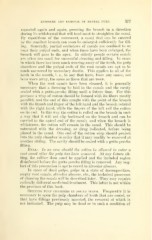Page 731 - My FlipBook
P. 731
EXPOSURE AND REMOVAL OP DENTAL PULP. 377
repeated again and again, pressing the broach in a direction
during its withdrawal that will tend most to straighten the canal.
By repetitions of the movement, a canal that can be entered
by the smallest broach can soon be enlarged sufficiently for fill-
ing. Generally, partial occlusions of canals are confined to or
near their pulpal ends, and when these have been enlarged, the
broach will pass to the apex. In elderly people certain canals
are often too small for successful cleaning and filling. In cases
in which there has been much wearing away of the teeth, the pulp
chambers and the pulpal ends of the root canals are apt to be
much narrowed by secondary dentin. This applies to all of the
teeth in the mouth, i. e., to any that have, from any cause, not
been worn away, the same as those that are woim.
When the root canals have been cleaned, it is generally
necessary that a dressing be laid in the canals and the cavity
sealed with a gutta-percha filling until a future time. For this
purpose a wisp of cotton should be formed with its fibers mostly
parallel, and the end of this caught with the point of the broach
with the thumb and finger of the left hand and the broach rotated
with the right hand, while the fingers of the left roll the cotton
on its end. In this way the cotton is rolled on the broach in such
a way that it will not slip backward on the broach and can be
carried to the apical end of the canal ; and when the broach is
withdrawn, the cotton will remain in the canal. This should be
saturated with the dressing, or drug indicated, before being
placed in the canal. One end of the cotton wisp should project
into the pulp chamber in order that it may readily be removed at
another sitting. The cavity should be sealed with a gutta-percha
filling.
Rule: In no case should the saliva be aJlotved to enter a
root canal after the pulp has been removed. At any future sit-
ting, the rubber dam must be applied and the included region
disinfected before the gutta-percha filling is removed. Any neg-
lect of this precaution is apt to result in alveolar abscess.
In cases of dead pulps, pulps in a state of decomposition,
empty root canals, alveolar abscess, etc., the technical processes
of cleaning the canals will be described later. They may require
radically different medicinal treatment. This latter is not within
the province of this book.
Opening pulp chambers in sound teeth. Frequently it is
necessary to open the pulp chambers of teeth that are sound, or
that have fillings previously inserted, the removal of which is
not indicated. The pulp may be dead or in such a condition of


